Report On IND BARATH Land Acquisition Study
Puspanjali Satpathy Sikhya Babu
Introduction
Land has always been an integral part of man’s life. Every being on earth depends on land, but the importance one attaches to it varies from person to person, from community to community. For most of us land is something which can be bought with money and once acquired the ‘land’ itself loses its meaning for us. What becomes important is the structure that we build above it or the minerals and ores that lie below it. But there are others for whom land is priceless, it is sacred. They believe land does not belong to man, its man who belongs to the land. For them land is a way of life. They understand land like no one else does or can. Therefore they have learnt how to use the land in a sustainable way without causing any permanent damage to it. In other words they have always known the difference between their ‘needs’ and ‘wants’, which unfortunately we could never learn. This clash has been a major reason for most of the conflicts between ‘we’ the urbanized mass, and ‘them’ the deprived and marginalized sections of the society. This clash has taken a new turn with the unprecedented rise in the number of industries, both in public and private sector. Industry is seen as a prequel to development and with this motto the government has been promoting industrialization like never before.
In Odisha, due to fast paced industrialization, the value of land has increased manifolds. The Jharsuguda belt has seen many land acquisitions for setting up of various industries. Government records show that there are 11 medium and large scale industries and over 25 mineral leases in the district. (Source: http://jharsuguda.nic.in/home.htm) The mantra ‘industry leads to development’ of the government is constantly encouraging companies to explore this region. Ind Barath Energy (Uktal) Ltd. is one of those many companies. This company has proposed to set up a 2X350 MW coal based thermal power plant at Sahajbahal village of Lakhanpur block in Jharsuguda district. The coordinates of the site as per Survey of India topo-sheet no 64 –O/14, scale 1:50,000 is
Latitude: 21°39’06” N to 21°40’16” N
Longitude: 83°55’28’’ E to 83°56’16” E
Sahajbahal is one of the villages in Lakhanpur Block. It consists of around 85 families of which majority belong to scheduled caste and scheduled tribe. Of the 85 families, aound 50 have shifted closer to the forest since over a generation. The main village could not accommodate the growing population, so these families cleared a patch of their village forest and moved there. They have continued living here since the last 60 to 70 years. However they are considered vey much part of the main village. Forest has been a vital source of livelihood for the people, along with agriculture.
History Of Protection
Sahajbahal has a unique yet very unfortunate story to tell of itself. This village on one hand has a forest protection history of 300 years, which makes it the oldest community managed forest in Odisha. The people have kept tab of the grain paid to the guards over all these years. These record books help us to ascertain their long association with the forest. The present records show that the forest of Lapanga in Sambalpur district has been protected since 1936, which is since 75 years. Sahajbahal beats Lapanga by a huge margin! The gramya jungle (village forest), named Dumdumi, covers an area of 86 acres; this patch of forest has been protected and managed so effectively that it survives even today. They shared with us interesting story on what made their forefathers protect their forest. The forest which survives today belongs to the people. But during the Zamindari era, many acres of Government land which also included forest were under the possession of the Zamindars. Later when Zamindari was abolished, many Zamindars were paid compensation for those lands, though they never belonged to them in the first place. This was the case of Sahajbahal as well. There was the patch of forest adjoining the village forest on which the zamindar claimed possession. Though the people were dependent on this forest as well, the zamindar did not allow them to use the resources. The forest was neglected and over used by him. The difference in the forest use pattern is evident here: the people used the forest sustainably where as the gountia simply exploited the forest for money. The people could see in front of their eyes how such a huge forest was getting reduced to nothing. This pushed them towards protecting their own forest and the tradition has survived 300 years. Since the last 20 years under various plantation schemes the government has been trying to revive the zamindar occupied forest. But the forest is nowhere to be seen. Another unique feature of this forest is that it has remained untouched from Forest Department’s interference over all these years. It must be noted here that the people cleared a patch of a land near their forest and moved there 60 years back. They used the Sal wood for the construction of the house built then. This shows that the people depended on the forest and had the right to use it when and as needed. Now coming to the unfortunate part of Sahajbahal’s story. The thermal plant that has been set up by Ind Barath threatens the existence of this very forest.
Land Acquisition
In Sahajbahal alone the company has bought 450 acres of land. When we talked to the locals many matters came to light. The majority of the land that Ind Barath has acquired belonged to the gountia who readily agreed to sell it. After he sold his land the villagers had little option. The others in the village owned very little land in comparison which forced them into selling it. However it is a pity that people have given up their land without any audible protest. Sahajbahal is merely 10 km away from Ib Thermal; the people have seen the horrors of industrialization, loss of livelihood, pollution and displacement very closely. So one expected them to protest against any company that wanted their land. The people expressed their plight with a very simple metaphor. The axe, they said, is nothing when we just look at the iron edge and wooden handle separately. The wood that goes into the axe comes from the forest, and it is the same wood when attached to a sharpened iron ultimately ends up cutting the forest which gave it live. Similarly the zamindar came from the same people, however when he got the support of the company (the sharpened iron) he ended up destructing the very people (forest) who supported him someday.
The company as of now says the land it has acquired does not include the forest land. But in a shocking revelation, few government officials claim that the company has acquired over 200 acres of forest land illegally. This came to light when we were discussing the matter with some local activists. The people when asked on what they thought their future would be after the company starts functioning, they said they could still stay in the village as promised by Ind Barath, but in a tone which was far from convincing. If one heard them closer, one could hear the unsaid fear and the desperate hope for their belief to be true. However in other parts of the village people were more vocal of their village. They said ‘company amar jagah k pura tha (O) kari ghini neiche, amku ta jibar k hein padba inu’ meaning the company has bought our land all around, we have no choice but to leave this place.
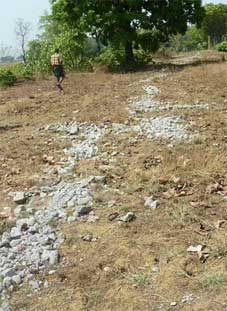
Fig. 1: This picture shows a portion of the boundary wall of constructed by the company near the Dumdumi Forest. The villagers destroyed the boundary as a mark of protest.
Initially 240 Ha of land was proposed to be acquired, which was later increased to 290 Ha. The company has bought the required land from Sahajbahal, Kurmimal and few adjoining village.
The company’s land requirements are as follows
|
Sl. No. |
Particulars |
Area(Ha) |
|
A. |
Main Power Plant |
|
|
1. |
Plant |
36.0 |
|
2 |
Coal handling system including Railway Marshalling yard |
60.0 |
|
3 |
Water system |
22.0 |
|
4 |
Road |
8.0 |
|
5 |
Misc. storage yard |
24.0 |
|
6 |
Ash handling system |
2.5 |
|
Sub-total |
152.5 |
|
|
B. |
Green belt for Power plant and ash pond area |
57.5 |
|
C. |
Ash pond |
20 |
|
D. |
Township |
10 |
|
Total |
240 |
Source: Environment Impact Assessment and Environment Management Plan of IBEUL, January 2009
The particulars of the land use patterns in the acquired area, as claimed by the company are given in the following table:
|
Sl. No. |
Particulars |
Area (Ha.) |
|
|
Govt. |
Pvt. |
||
|
1 |
Agriculture |
||
|
Irrigated |
- |
0.0 |
|
|
Unirrigated |
- |
192.53 |
|
|
2 |
Homestead |
- |
0.8 |
|
3 |
Fallow |
30 |
- |
|
4 |
Others |
16.67 |
- |
|
Sub-Total |
46.67 |
193.33 |
|
|
Total |
240 |
||
Source: Environment Impact Assessment and Environment Management Plan of IBEUL, January 2009
Flaws In Land Acquisition
Tribal Land Acquisition
The land acquisition has been done very tactfully in this village. Majority of the people are tribals whose land can not be bought by a non-tribal as per the law. But the company has successfully acquired many acres of tribal land. How this has been done? Is the district administration aware of it? These are few of the questions which have no answers as of now. The people had their own version. They said they were made to transfer their land in the name of some person and the company bought the land from that one person. This explanation, however, does not clear matters sufficiently. Majority of the villagers need to give their consent before the company is allowed to acquire land. Keeping this in eye the company has been paying cash to 100% villagers so that at no point they try to revolt against it. The company has been paying the each villager money (3000 rupees to each male senior citizen and 5000 to the young who are eligible to work) as ‘compensation’ till it offers them job. So one way to look at this would be the company is paying the people for doing nothing, thus literally buying them with each day.

Fig. 2:This AC was seen in one of the houses of the village. It is one of effects the consumerism which has been promoted with the advent of industries.
No FRA Implementation
The district administration has not implemented the Forest Rights Act in this village even though there is so much of forest cover on which people have depended since generations. The people had absolutely no idea of their rights under FRA. Some said they have heard of something called FRA in one of their Panchayat meeting but nothing in that regard has been done by any officials. The people have been staying in forest land for more than 75 years, so both the tribals and other traditional forest dwellers can claim their rights. There are around 15 to 18 tribal families who have been cultivating the forest land occupying 50-60 acre land in all. In fact almost all of them have encroachment cases filed against them which a primary evidence to claim title for the land under FRA. Also the land where they are presently staying is forest kind land. So titles for this land can also be claimed. The CFR claim can also be made for their forest. How a private company has managed to procure land in a FRA unsettled village is a pertinent question. When we talked to the SDLC officials they had a different version to say. The officer claimed that the FRA settlement in Lakhanpur block has been ‘completed’. When he was told about Sahajbahal he tried to cover it up by saying it might be among ‘those few villages we have missed’! The table below gives the FRA status till January 2012 in Jharsuguda district:
|
Particulars |
Forest Right Committee |
SDLC |
DLC |
|
|
Individual claims |
Number |
9204 |
2354 |
2319 |
|
Area |
9427.39 |
2107.9 |
2098.71 |
|
|
Community claims |
Number |
8 |
2 |
2 |
|
Area |
9.35 |
4.50 |
4.50 |
|
Source: SC-ST Department, Govt. of Odisha
Resettlement And Rehabilitation
According to section 2 and 42 of the Land Acquisition Rehabilitation and Resettlement Policy 2011 if a company acquires more than 100 acre in rural area, the responsibility of resettling the people lies with the company. And it seems Ind Barath has taken up this responsibility very seriously. On one hand, it has assured the people that they will not be displaced, but on the other hand the constructions of the resettlement houses are going on in full swing! The villagers of a displaced hamlet have already refused to stay in those houses and just one look at them can tell you why. Those tiny concrete structures can never appeal to the villagers who have lived all their lives amidst greenery. The photo below shows some of these structures
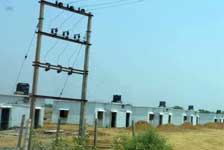
Fig 3:Photo showing the houses built to rehabilitate the displaced.
Irregularities In Purchase Rate
The people had demanded the company to buy their lands as per the prevailing rate in Jharsuguda. The company on its part had agreed that it will ‘pay well’ for the land it has acquired. However it has paid 1,60,000 rupees per acre which is peanuts compared to the prevailing Jharsuguda rate. (We gathered that at some places the rate is as high as 70 lakhs per acre!) That is not all, even though the company has paid 1.6 lakh per acre, the sale has been registered at 80,000. When questioned in this regard, the company had vaguely explained the people that it is for their own good. It said if in future any family member claims right over this land they could show them that the land was sold at 80,000. But the real reason behind this is quite simple: the company has to pay less registration fees when it says the land was bought at 80,000 rupees.
Environmental Concerns
The land that the company has acquired for the construction of its ash pond is right next to the Hirakud Reservoir and very close to human settlement. One fails to understand how it received the environmental clearance for the same. Most of the land that has been taken away by the company is fertile agricultural land, even though un-irrigated. Even though the government records list this land as ‘un-irrigated’, the presence of the vast Hirakud Reservoir does not necessitate irrigation in these parts. On one hand the government talks of food security, but does not hesitate to sell the same to companies in the name of development.
Forest And The People
The forest has always been a source of livelihood in this village. The Char and Mahua trees have ensured that each individual earns 1500 to 2000 rupees each year. The oil requirements of a year get fulfilled from the Tol (Mahua seed) oil. The other forest produce includes Sal leaves and Kendu leaves. The women especially have been greatly empowered as they have contributing financially to their families. On our way to the forest, we met a very old lady who was on her way back after collecting Palash leaves from the forest. Even at her age she is financially secure; she personifies all those women whom the forest has made independent. When a company like Ind Barath takes away such forest, it also takes away the independence and confidence of many women like her. Beedi making is also one of the occupations which provide income to many people. Bena Chera (a type of scented root) also generates lot of employment. People dig up these roots, clean them and sell them at 2 rupees per bundle. In a day they earn close to 200 rupees from this. These days some people have gone a step ahead and are making semi-finished products themselves. These roots are used in coolers and for windows (like curtains). The people take measurements and prepare these products themselves, 3 sides of the product used in coolers sells at around 70 to 100 rupees. However the quantity of Bena Chera has been drastically reduced since the advent of Ib Thermal. One of the villagers noted that even in his father’s time the forest generated income. He said in those days 1 kg of char seed could be battered with enough salt which could last an entire year. Thus the forest has always been a provider to the people.
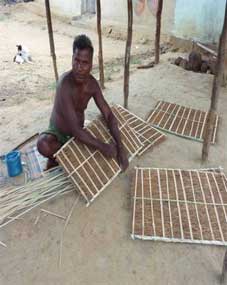
Fig 4: A villager working with Bena Chera. These products used in coolers fetch around 70 to 100 rupees.
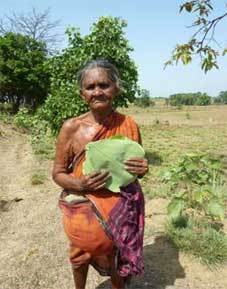
Fig 5: This women is representative of all those elderly especially women whose livelihood is sustained by the forest.
System Of Forest Protection
The company or the state does not have any regard for this independence. The forest was managed and protected by the villagers in their own way. Initially they paid the guard in terms of grain which was collected from each household. Each family contributed 2 khani, that is 40 kg of grain a year and the guard was paid 5 khani, 100 kg a month. Later they themselves took turns in guarding the forest. The forest which was once belonged to the people is protected today with the company’s money. We could feel the lowering of tones and the gesturing among themselves when they said this. It is an embarrassment for them to accept money from an outsider to protect something which they consider a part of themselves. These little things show how the entire lesson of self reliance and empowerment which the forest taught the people, stands defeated today. But this also exposes a big irony which the state always maintains: industry ‘empowers’ people! Try saying that in Sahajbahal!
Making And Unmaking Of A ‘God’
Kurmimal is an 82 family strong village located near Sahajbahal. This is a relatively new village; most people have been here since two or three generation. The people have resettled here after their original villages Rampela and Dihupara got acquired for the Hirakud Project. Of 1800 families displaced from Rampela and 600 from Dihupara, only 70 chose Kurmimal. The rest of the families scattered into other places like the Rampela Camp, Chauladhipa, Rengali Station and Ganesh Nagar. One can say these 70 families were made to choose Rampela. The Rampela gountia, Satrughan Panda required man power to cultivate his huge agricultural lands located in Kurmimal. So he made a tempting offer to the people: He said the people need not get into any hassles; instead they could stay and cultivate his land in Kurmimal. This gesture of the gountia elevated him to a God-like status amongst the masses. The villagers readily agreed to cultivate his land as share croppers. However it was a big mistake whose price the people are paying today. The initiatives and efforts of Mr. Prasanna Panda, then communist leader saw some of the landless SC-ST getting 5 acres of land. He made it his life long mission to fight for the rights of the displaced. But none of the families of Kurmimal came forward with their demand. They kept waiting for the land to come to them, and it has been a long wait.
It is today, when the people are on the verge of getting displaced for the second time, they have begun to realize the mistake made back then. Here is why. The land of the zamindar which had been their source of livelihood is now a property of Ind Barath. The present day family of the zamindar, the lesser Gods gave in to the millions that were in offer without a little thought to the plight of the hundreds who depended on those lands. So today the people of Kurmimal are not only landless but also jobless. This land will be used for the construction of the ash pond of the thermal plant of Ind Barath sent up in Sahajbahal.
Island Of Nomads
With this purchase Kurmimal will soon become an island, isolated and cut off from the outside world. Presently the village is surrounded by the reservoir waters on three sides that is north, south and east. On the west lies the only road that links it to the other villages. The agricultural fields on either side of the road belonged to the Rampela gountia. This is the land that the gountia sold to the company. The total area is close to 150 acres of which 118 acres have been bought by Ind Barath. Such is the location of the site that the villagers will be compelled to move when the ash pond is built.
This strategy of the company serves many purposes with a single stroke
-
The people will move out on their own, so the company does not have to bear the responsibility of relocation and resettlement.
-
It gives the company more land for any future expansion which it will definitely need. The presently acquired land for ash pond is very small for a 750 MW plant.
-
The ash pond can be constructed without any environmental issues to take care of. The does not permit construction of ash pond within 500 meters of human settlement.
We could see that the company has already started clearing the land. The demarcations have been broken down to convert the agricultural lands into plains. It looks like the construction of the ash pond is going to start very soon.
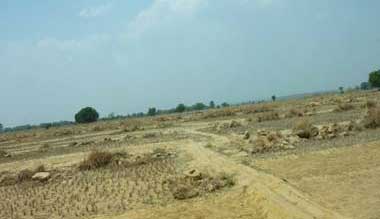
Fig 6:The agricultural land acquired by Ind Barath in Kurmimal for the construction of ash pond
Story Of Eternal Neglect
Kurmimal is one of those villages of the state which has been neglected since its inception. This village does not have proper water or electricity supply. The villagers have to travel miles even for their basic requirements. There is no hospital or school in the vicinity. Even after 60 years of getting displaced the people have not received any compensation of any kind. Almost everybody is landless even though the officials claim otherwise. They said the villagers have been offered and under the Vasundhara scheme. But none of the locals know where this land is.
The other livelihood source for the people has been fishing. The proximity to the Hirakud reservoir makes fishery a natural choice. But today this livelihood is also under threat. The high levels of pollution have drastically reduced the quantity of fish in the reservoir. And it goes without saying that the thermal plant of Ind Barath will go a long way in further reducing the numbers. The land acquired is just next to RL 632 which is a part of the reservoir according to the records of Water Resource department. According to the environmental laws an ash pond can not be constructed 500 meters from a water body and 500 m from human settlement. In case of Ind Barath both laws are being openly flouted.
FRA In Kurmimal
The dependency of the people in this village is primarily agriculture and fishing. The people did not have any significant forest land near their village. The nearest forest is 2 km away in Rengali and the people bring their firewood etc from this forest. None of the villagers have heard of anything called the Forest Rights Act. We spoke to them on how they could legally ascertain their dependency on the Rengali forest by discussing the matter with them. The people could also claim CFR for their own village forest.
The FRA has various sections devoted to help the displaced people establish their rights. But since the government has not created any awareness amongst the masses on FRA, expecting the people to demand for their rights will be asking too much.
Land Allotment In Kurmimal
The government has many provisions to provide land to the landless tribals. But nothing has been applied in Kurmimal. When we spoke to the district administration on this matter they simply said the people have been allotted land under the Vasundhara scheme. However, only one villager Snehalata Bhoi showed us her patta. But even she had no idea where this land is situated. The land allotted in this scheme is just 4 dc, which includes only homestead land. The village is very close to RL 632. During the Hirakud Project land acquisition the Water Resource Department had anticipated the reservoir water to reach maximum of RL 632. But today the unprecedented water requirement of the various industries mushrooming in Western Odisha has pushed the water level to as low as RL 620 in some places. So, vast area of land is lying unused which could be given to the landless. The government claims that they have taken initiatives in this regard, but nothing has materialized as yet.
In Kurmimal the villagers have traditionally used some of these lands for their cultivation. In fact in some parts of Jharsuguda there are special varieties of rice that grow in water. The locals call it ‘Jal Budi Dhan’ which is sowed after the water has receded. The saplings attain a much greater height as compared to normal breeds so that when the water level rises the plant is above the water. The rice is harvested by going in the water using boats!
Sahajbahal and Kurmimal are one of those many villages across India which is being forced into industrialization. Nehru’s words ‘if you are to suffer, suffer for the country’ has been nailed so deep into their minds that many feel it is noble to sacrifice their land, their homes, their livelihood without a whimper of protest. Wish this sacrifice did us any good… what these people sacrifice today could have been a legacy for our tomorrow. Each of these industries has a maximum life of just about 30-40 years. After that they leave prints of destructions which are almost impossible to erase. Sustainable and mindful use of resources is the only way that could lead us to a better tomorrow.
Vasundhara, Bhubaneswar, Odisha



